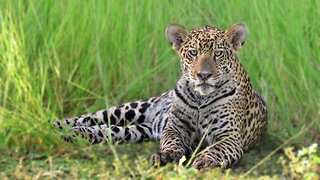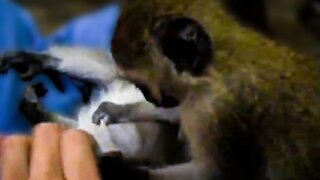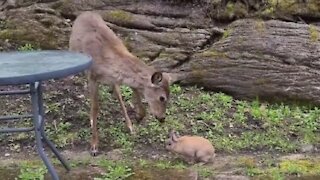Rescued Saki Monkey wants to befriend caretaker
This Saki Monkey was rescued from the illegal pet trade, and now lives at a rescue center in the Peruvian Amazon. She is very nice, but also very shy, and doesn't let people pet her and such, but she does want to befriend her caretaker. She is still unsure about it, and only approaches her and the caretaker looks away, then the monkey comes close and touches her hand. Little by little a friendship is born… animals are fascinating!
Saki Monkeys are New World Monkeys belonging to the Pithecia genus. Sixteen species are recognized: the Equatorial Saki (Pithecia aequatorialis), the White-footed Saki, also known as the Buffy Saki (Pithecia albicans), the Cazuza's Saki (Pithecia cazuzai), the Golden-faced Saki (Pithecia chrysocephala), the Hairy Saki (Pithecia hirsutea), the Burnished Saki (Pithecia inusta), the Rio Tapajós Saki, also known as the Gray's Bald-faced Saki (Pithecia irrorata), the Isabel's Saki (Pithecia isabela), the Monk Saki (Pithecia monachus), the Miller's Saki (Pithecia milleri), the Mittermeier's Tapajós Saki (Pithecia mittermeieri), the Napo Saki (Pithecia napensis), the White-faced Saki (Pithecia pithecia), the Pissinatti’s Bald-faced Saki (Pithecia pissinattii), the Rylands' Bald-faced Saki (Pithecia rylandsi), and the Vanzolini's Bald-faced Saki (Pithecia vanzolinii).
Saki Monkeys have long, coarse, fluffy hair, which puffs up when they feel threatened, making them look bigger. Coronal hairs are directed forward, making them look like they have bangs.
They are native to the rainforests of South America and rarely come down to ground. They tend to prefer mature forests including various flooded forests, such as várzea, which is the white-water flooded forest, igapó, the black-water flooded forest, palm swamp, also known as Mauritia swamp, and terra firma forest. They are also found in disturbed habitats and in fragments that have secondary forest, although they feed on seeds of large forest tree species, especially the ones in the family Lecythidaceae, which are usually in mature forest.
-
 0:40
0:40
NataliaCara
1 year agoEncountering a beautiful jaguar cub in the wild!
5791 -
 1:01
1:01
BlackDogFarmAndRescue
2 years ago $55.04 earnedCat Desperately Tries to Befriend Rescued Goat
16K19 -
 0:29
0:29
NataliaCara
3 years agoRescued baby monkey wants to help groom her friend
7.86K15 -
 0:12
0:12
ViralHog
3 years ago $0.27 earnedMonkey Wants Food from Baby Chef
1K1 -
 0:23
0:23
BlackDogFarmAndRescue
2 years ago $165.92 earnedRescued puppy tries so hard to befriend unimpressed cat
10.4K36 -
 0:35
0:35
BlackDogFarmAndRescue
3 years ago $86.68 earnedRescued Bull Terrier Attempts To Befriend Grumpy Cat
31.3K23 -
 0:16
0:16
Deer In Nature
3 years ago $39.38 earnedSweet deer really wants to befriend kitty cat
123K222 -
 1:38
1:38
Deer In Nature
3 years ago $139.54 earnedWild deer really wants to befriend little bunny rabbit
492K257 -
 0:29
0:29
MelanieWenger
3 years ago $11.14 earnedAussie puppy desperately wants to befriend a grumpy cat
34.4K24 -
 0:13
0:13
jillzymarie
1 year ago $141.24 earnedRescued Dog And Fawn Have Become Best Friends
12.9K44